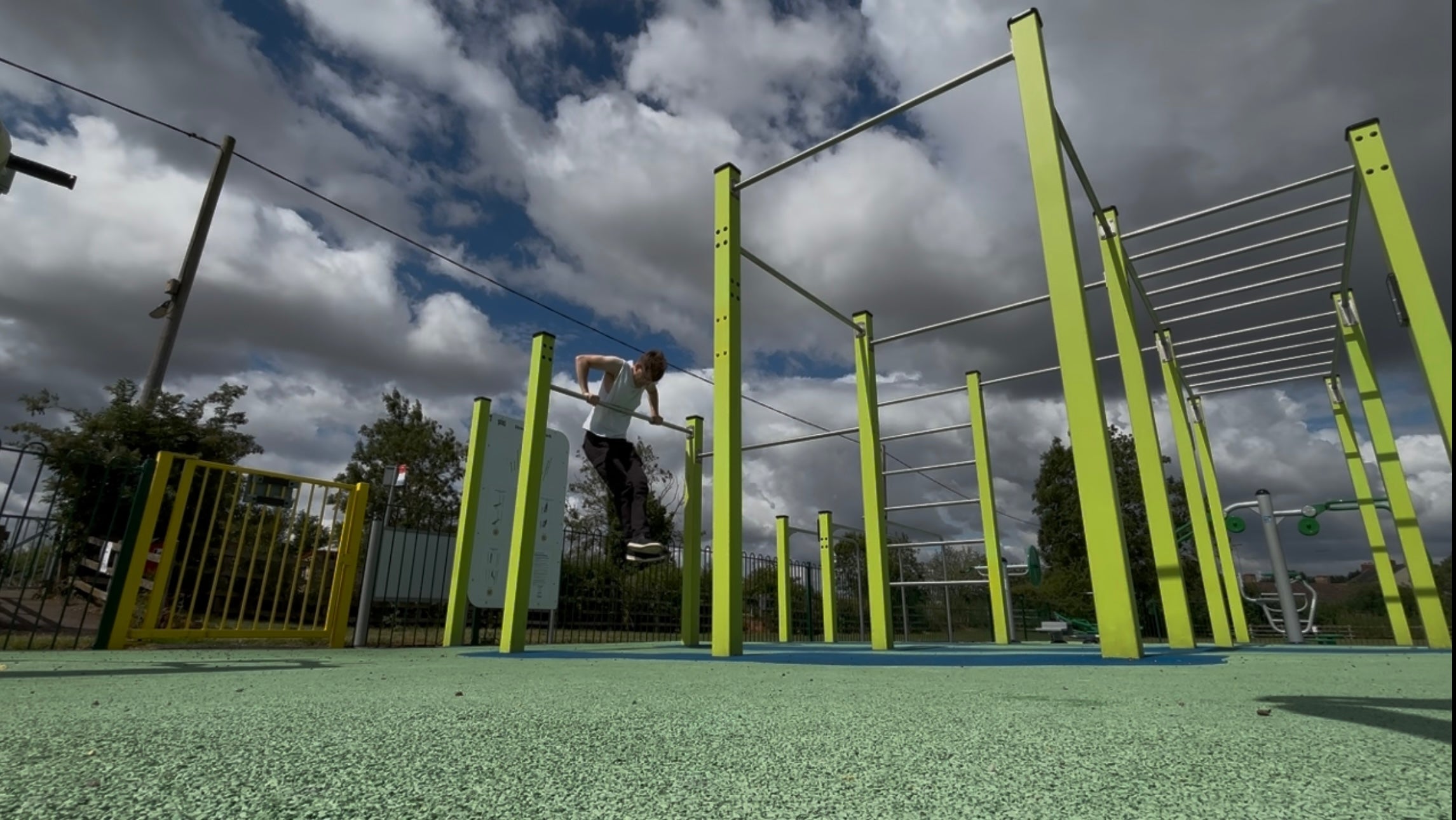
FAQ
Calisthenics FAQs: Build Muscle, Lose Fat & Train Anywhere in the UK
Can calisthenics build muscle?
Yes. Progressive bodyweight training builds serious lean muscle. Use progressive overload (harder leverages, slower eccentrics, added load via backpack/dip belt), train key compounds (pull-ups/chin-ups, ring rows, dips, press-ups, squats/pistols, handstand work) 2–4×/week, and support with protein (~1.6–2.2 g/kg) and sleep. Track reps/tempo, level up when sets are clean, and periodise for hypertrophy.
Ready for a phased plan? We provide week-by-week targets and feedback in our UK online coaching.
People also ask:
- Are calisthenics good for building muscle?
- Will calisthenics build muscle?
- How do calisthenics build muscle?
Are calisthenics better than weights?
It depends on your goal: bodyweight training excels for functional strength, mobility and skill (great for outdoor gyms and home workouts), while barbells allow fine-grained load jumps for maximal hypertrophy/Powerlifting; many UK athletes blend both for best results.
Are calisthenics good for weight loss?
Yes. Full-body circuits raise heart rate and preserve muscle, helping you look leaner while a modest calorie deficit drives the scale down.
Combine 2–3 strength sessions with daily steps, keep protein high, and progress weekly for sustainable results.
We’ll set your training and nutrition targets in HQ coaching.
People also ask:
- Will calisthenics make me lose weight?
Are calisthenics good / effective / good for you?
Calisthenics are highly effective for functional strength, mobility and cardiovascular health with minimal kit - ideal for home or outdoor gyms across the UK. Compound bodyweight moves train multiple joints efficiently, improving posture, balance and conditioning from beginner to advanced.
Want structure and accountability? See our online lessons.
People also ask:
- Are calisthenics good?
- Are calisthenics effective?
- Are calisthenics good for you?
Can calisthenics burn fat?
Yes. Strength circuits (push/pull/legs) and skill practice increase energy expenditure while preserving muscle, which is crucial for fat loss. Pair training with a consistent calorie deficit, aim for daily step goals, and use Every Minute On the Minute/As Many Reps As Possible finishers for time-efficient conditioning.
Get a fat-loss-focused plan inside the Calisthenics HQ community.
People also ask:
- Will calisthenics burn fat?
How do calisthenics change your body?
Expect improved posture, joint control and athletic muscle, especially back, shoulders, arms and core, plus better mobility and coordination from skills like handstands and levers.
What calisthenics workout should I do?
Begin with 2–3 days/week of push (press-ups/dips), pull (rows/pull-ups) and legs/core (squats, lunges, hollow body); pick progressions you can manage for 6–12 quality reps and add reps or difficulty weekly.
Calisthenics HQ can help build your plan around your equipment and schedule - learn more
What calisthenics equipment do I need?
A pull-up bar and a pair of rings cover 95% of training; resistance bands help with assistance/mobility, and a weighted backpack or dip belt adds load as you advance.
What calisthenics work chest?
Ring press-ups, ring dips, pseudo planche press-ups, wide press-ups and slow tempo eccentric reps hammer the chest; progress by elevating feet, moving to rings and adding load.
What calisthenics work back?
Pull-ups, chin-ups, ring rows, front-lever tucks and archer pulls build lats, mid-back and biceps; vary grips and tempos to keep progressing.
What calisthenics work shoulders?
Pike push-ups, wall handstand holds/push-ups, ring support holds and face-pull rows strengthen delts and rotator cuff; prioritise controlled range and scapular stability.
When will I see results from calisthenics?
Most beginners feel stronger in 2–4 weeks and notice visible changes in 6–12 weeks with consistent training, protein and sleep; skills like handstands progress steadily with daily micro-practice.
Where to start with calisthenics?
Master basics - hangs, hollow/arch holds, bodyweight rows, press-ups, squats, lunges and planks - then add pull-up/dip progressions and core work; train 2–3 days/week and walk daily.
Start our beginner pathway in the Calisthenics HQ community on Skool
Are calisthenics good?
They’re excellent for building practical strength, mobility and coordination with minimal kit, ideal for home or outdoor gyms across the UK.
Can calisthenics build abs?
Definitely. Hollow body work, hanging knee-to-toe raises, L-sit progressions and anti-extension/rotation drills build visible, functional core strength
Can calisthenics make you stronger?
Yes. Skills like pull-ups, dips and handstand push-ups deliver serious relative strength; progressions and added load keep you advancing for years.
How do calisthenics train legs?
Use unilateral patterns (split squats, step-ups, pistols), tempo control and holds; add backpacks or Bulgarian split squats to push intensity without machines.
How do calisthenics workouts work?
They use bodyweight resistance and gymnastics-style progressions to challenge muscles through full ranges; sessions combine push, pull, legs and core with skill practice.
What calisthenics work biceps?
Chin-ups, close-grip ring rows, curls with rings/towel and isometric holds at 90° crush biceps; slow eccentrics boost growth.
When should I progress in calisthenics?
Once you own perfect form for all prescribed reps/sets, add reps, slow the tempo, move to harder progressions or add weight, change one variable at a time.
Is it safe to do calisthenics when pregnant?
With medical clearance, many can continue gentle bodyweight training focused on posture, breathing and pelvic-floor-friendly moves; avoid maximal strain and supine positions later on - always follow your clinician’s advice.
Is it safe to do calisthenics when sick?
Follow your doctor's advice.
If symptoms are above the neck (mild), light movement may be okay; if you’ve fever, chest symptoms or significant fatigue, rest until recovered - health first.
Can you do calisthenics when overweight?
Yes. Start with elevated press-ups, band-assisted rows/pull-ups and chair-supported squats; focus on technique, short sets and consistent walks while managing nutrition.
Which calisthenics programme is best?
The best plan matches your level, goals and schedule, progresses weekly and includes feedback; avoid random workouts and chase measurable targets.
Our phased programmes do exactly this - see coaching
Which calisthenics skills should I learn first?
Prioritise pull-ups, dips, handstand foundations, L-sit and hollow/arch positions; these unlock levers, muscle-ups and advanced push-ups later.
Which calisthenics app is best?
Choose a platform with clear progressions, form checks and coach support, not just timers.
Our community provides lessons, programmes and feedback in one place. Start your training inside Calisthenics HQ
Can calisthenics make you taller?
No. Training won’t increase height, but it improves posture and spinal control so you stand taller and look more athletic.
Can calisthenics grow glutes?
Yes. Bulgarian split squats, step-ups, hip hinges, single-leg RDLs and deep squat holds grow glutes; add tempo and load as you advance.
How have calisthenics changed my life?
Members tell us they feel stronger, leaner and more confident, with better mobility and routine - training anywhere from London parks to home gyms across the UK.
When did calisthenics start?
The word traces to 19th-century physical culture, but the practice - gymnastics-style bodyweight training - dates back to ancient times; today it’s thriving in UK outdoor gyms.
Calisthenics — which country?
Global today; you’ll find outdoor gyms and communities across the UK - from London to Manchester, Bristol and beyond - making it easy to train anywhere.
Which muscles does calisthenics work?
Everything. Lats, chest, shoulders, triceps, biceps, core and legs—through compound, multi-joint patterns; progressions ensure continual challenge.
Who invented calisthenics?
No single inventor; it’s an evolution of historical bodyweight training and gymnastics shaped by many coaches and cultures.
Who is the best calisthenics athlete in the world?
Vadym Oleynik calls himself the strongest calisthenics athlete in the world. Chris Heria is the most well known, an icon. While others like Jasi Svilenova and Aspen Vincent are notable female freestyle and strength competitors, and Simon Imhauser is a champion in heavy calisthenics.
Standouts change yearly and by discipline (freestyle, statics, endurance); instead of chasing names, benchmark your own progressions and PBs. We’ll set targets that actually matter: train with us
Who is the calisthenics influencer?
You're probably thinking of Chris Heria. A calisthenics legend.
But there are many - focus on coaches who teach progressions safely rather than just showcase tricks; look for programming clarity and results.
Why are calisthenics athletes so strong?
They master high tension through long lever arms, strict technique and excellent scapular/core control, producing exceptional relative strength.
Build that foundation with our skill pathways.
Why are calisthenics better than weights?
For many, they’re more accessible, joint-friendly and skill-rich, delivering strength, mobility and coordination with minimal kit - perfect for home and outdoor training.
Will calisthenics make me bulky?
Maybe. Calisthenics builds lean, athletic muscle; significant “bulk” requires high calories and heavy progressive loading.
Will calisthenics make me lean?
Yes. Paired with a sensible calorie deficit and steps, bodyweight strength preserves muscle while you drop body fat, delivering that lean, athletic look.
Can you get fit just by doing calisthenics?
Yes. Calisthenics alone can build strength, muscle, mobility and cardiovascular fitness using scalable bodyweight progressions and short conditioning circuits at home or in UK parks.
Train 3–5 days per week, track reps/tempo, and mix strength sets with Every Minute On the Minute/As Many Reps As Possible finishers for heart-health.
What is the 80/20 rule in calisthenics?
Apply Pareto: 20% of actions drive 80% of results - master the big rocks (sleep, protein, steps) and core moves (push-ups/dips, pull-ups/rows, squats/lunges, planks/hollows) with progressive overload, and skip fluff skills until the basics are strong; for fat loss, think “nutrition is the 80,” training the 20 that preserves muscle.
Is 30 too late for calisthenics?
Not at all. 30 (or 40, 50+) is a brilliant time to start; begin with joint-friendly progressions, controlled tempo and smart volume, then add rings/pull-up bar work as capacity grows, improving strength, posture and energy without heavy kit.
Let's get you started today at Calisthenics HQ
Is 30 minutes of calisthenics a day enough?
Yes. 30 focused minutes is plenty for health, fat loss and strength if you keep intensity high and progress weekly: 5-minute warm-up, 20 minutes of push/pull/legs supersets, 5-minute core or conditioning finisher; aim for 5–6 sessions a week or 3 longer ones if you prefer.
When did calisthenics start / where did it originate?
Calisthenics as a practice (gymnastics-style bodyweight training) dates back to antiquity, was formalised through 19th-century European/US physical culture, and today thrives in modern street-workout and outdoor gyms.
The word itself is Greek: kallos (beauty) + sthenos (strength). It isn’t owned by one country; it evolved across military, gymnastic and physical-education systems.
We turn that heritage into practical, progressive programmes at Calisthenics HQ.
People also ask:
- When did calisthenics start?
- Where does calisthenics originate from?
- Where did calisthenics come from?
- Where was calisthenics invented?
- Where did calisthenics originate?
- Which language is “calisthenics” from?
Didn’t find what you were after?
Get fast answers, form checks and accountability with coaches and like-minded athletes.

